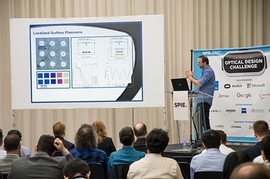 |
Date Announced: 08 May 2018
Biennial symposium broke attendance records and saw launch of new optical design competition at the city's renovated and expanded conference center.
BELLINGHAM, Washington, USA and CARDIFF, UK - A high-powered plenary line-up, a popular AR/VR/MR demo room, a terrific technical program, a bustling exhibition, and the success of a brand-new optical design competition for students set the tone for SPIE Photonics Europe's successful return Strasbourg this year.
The substantial plenary presentations showcased the work of six high-profile research scientists: Alain Aspect on quantum optics; Jeremy J. Baumberg on nanoscience; Jens Limpert on ultrafast lasers; Frank Koppens on ultrathin materials; Anne L'Hullier on attosecond physics; and Rainer Blatt on quantum computing and quantum information processing. Also during the four-day symposium, AR/VR/MR demos kept the designated room buzzing with activity; a Women in Optics networking opportunity focused on empowering women in STEM and tech; a "Light Culture" exhibit of 3D holograms proved to be a tremendous draw; and the first-ever SPIE optical design competition for students made its debut with a total of nine winners.
That competition was an integral part of the new Digital Optics for Immersive Displays conference chaired by Microsoft's Chief Optical Architect and SPIE board member Bernard Kress. The top prize went to Zhujun Shi of Harvard University, with two immediate runners-up, David Dunn, of the University of North Carolina, Chapel Hill, and Ori Avayu, of Tel Aviv University. Across the symposium, conferences focusing on quantum, nanophotonics, silicon photonics, and 3D printing/additive manufacturing sessions, drew large and engaged audiences
The industrial exhibition was lively throughout the week, with particular excitement and attention around the Innovation Village competition which supports and publicizes research teams from universities, non-profit institutions, and research centers, with a focus on new products or research transitioning out of the lab into businesses. Winners in two categories, individual project and multilateral project, were announced on Wednesday, April 25: each winner won €1,500, and two runners up in each category won €500.
The individual project winners were Physics Department of Politecnico di Milano, Italia, project NIREOS, Dario Polli team, for their VIS/NIR spectrometer; DAMAE and Charles Fabry Lab., Paris, France, project OCTAV, Arnaud Dubois team, for a new approach to dermatology diagnostics through a hand-held imaging device; ICube laboratory, University of Strasbourg, France, project Dermapol, Jihad Zallat team, for a real-time, spectro-polarimetric optical biopsy tool with dermatological application. The multilateral project winners were Empa, ETH Zurich and FHNW Swiss labs, Switzerland, project MIRO Analytical Technologies, for a multi-component gas sensor based on dual-wavelength quantum cascade lasers; Warsaw University of Technology, Poland, project OPTO-SPARE (with Military Institute of Aviation Medicine and TMS MS Diagnostyka), for an optoelectronic system for monitoring physiological parameters of patients under MRI diagnosis; CESNET association of the University of the Czech Republic, project CLDS-PhiOTDR, for their modular effective distributed fiber optic sensing system for acoustic/mechanical vibrations sensing.
"SPIE Photonics Europe 2018 was incredibly exciting," said Paul Montgomery, the local chair for Photonics Europe and deputy director of Strasbourg's ICube Laboratory. "Visitor and participant numbers were even higher than expected and every room seemed to be overflowing, resulting in an electric atmosphere and an expectation of great things: the entire week was very representative of what is happening now in European photonics. Among the seven new conferences, I was particularly delighted with the "Unconventional optical imaging" conference, an international version of an annual French national network meeting on the subject. To top it all, the conference has thrown many of us together, especially in the Grand Est region of North Est France and near-Rhine area, emphasizing the need for a local network in photonics. We plan to ensure that this impressive and successful week will contribute to building that as well as the next version of Photonics Europe here in Strasbourg in 2020."
"The quality of the Photonics Europe program exceeded all expectations as leading researchers in emerging fields such as digital optics, nanophotonics, quantum sciences, and metamaterials presented their latest findings," noted SPIE technical director Bob Hainsey. "Coupled with a record number of paper submissions and plenary presentations from the leading voices in quantum technologies, lasers, 2D materials, and attosecond sciences, the result was a dynamic week at this year's top optics and photonics event in Europe and the most successful Photonics Europe symposium to date. We look forward to returning to Strasbourg in 2020 and building on the energy and success from this year."
Throughout the week, industry reps, exhibitors, academics and other attendees interacted with each other as well as with the latest photonics technologies, ranging from the basic research and fundamental physics in research labs to those moving into real-world applications. The many networking opportunities, the engaged attendees, and the quality of work presented in the conferences showed why SPIE Photonics Europe in Strasbourg is the premier European location to find new business, exchange ideas and learn about photonics technologies.
Source: SPIE
E-mail: via web site
Web Site: www.spie.org
| © 2025 SPIE Europe |
|